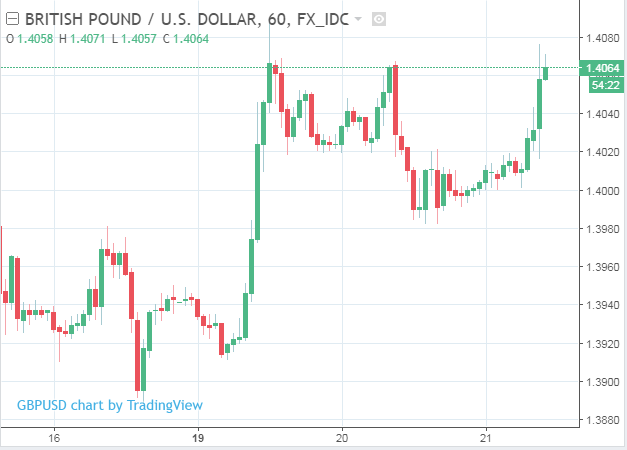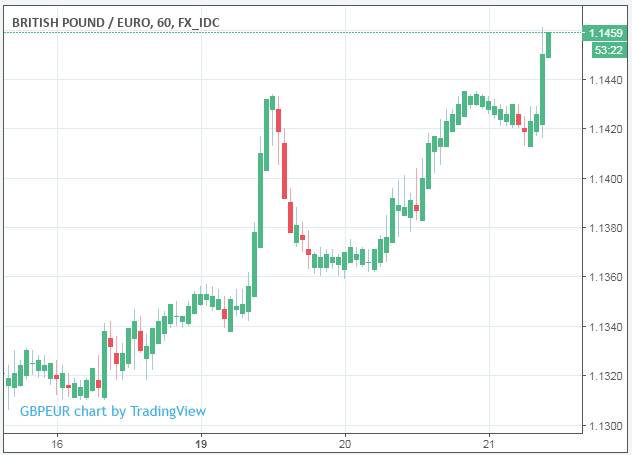Pound Sterling Rises as UK Wages Grow Faster than Expected in January and Unemployment Rate Falls
- Written by: James Skinner
- UK unemployment falls back to 4.3%, lowest level since 1975.
- Wages grow by 2.8%, much faster than expected.
- Wednesday's data likely seals deal on a BoE rate hike in May.

© Auremar, Adobe Stock
The British Pound rose against the majority of global currencies Wednesday as markets responded to the latest volley of labour market data, which showed UK wages growing faster than expected during January.
The Pound-to-Dollar rate was quoted 0.45% higher at 1.4062 following the releases, after extending an earlier 0.15% gain, while the Pound-to-Euro rate reversed an earlier loss to trade 0.18% higher at 1.1454, a move which if sustained would represent the 11th successive day of gains for Sterling against the Euro.
For markets, it was all about wages and pay rose by 2.8% during the three months to the end of January, up from 2.5% in the previous period. This is a larger increase than the 2.6% growth expected by the market and is therefore bullish for the Pound.
Separately, the unemployment rate fell back to 4.3%, which reverses a surprise increase from December and puts it back at its lowest level since 1975.
Employment and unemployment both rose - an apparent contradiction were it not for data that showed labour force participation also surged. This tells us previously economically inactive people are entering the market place to look for work once more. It was a rise in participation that pushed the unemployment rate up to 4.4% in the three months to the end of December.
There were 32.25 million people in work during the three months to the end of January, 168,000 more than in the previous quarter and 402,000 more than in the same period of 2016. This is nearly double the 88,000 number of new jobs markets had expected for the recent period.
"January’s labour market figures provided clearer signs of a revival in earnings growth, suggesting that it won’t be long before we start to see sustained rises in real pay," says Ruth Gregory, a UK economist at Capital Economics. "Overall, today’s figures add further weight to our view that the next interest rate hike will occur in May."
All round positive #UK jobs report. Strong employment gains (+168k), higher wages (headline 2.8%; ex-bonus 2.6%). Muted reaction in $GBPUSD ahead of Fed meeting. No reason why we can't get above 1.42 on a dovish Fed. $EURGBP might test 0.87. Let the good times roll for the pound! https://t.co/rd6AUcPx9n
— Viraj Patel (@VPatelFX) March 21, 2018
"Tepid wage growth has been the anchor around the British economy for some time, but today’s positive reading gives the Bank of England the green light to raise interest rates again in the near future," says Dennis de Jong, managing director at retail trading firm, UFX.
Wednesday’s wage figures will likely be seen as sealing the deal on a Bank of England rate hike in May, and could prompt some hawkish signals at Thursday’s monetary policy meeting as rising wages can spur inflation further down the line. The MPC indicated in February that rate hikes are likely to be needed “somewhat earlier” than it previously expected and market pricing now implies a 90% probability of a May move.
"The MPC has a small window to move: it will be able to point to the pick-up in headline wage growth, very limited spare capacity, and inflation – while declining – above target. And on Brexit negotiations there has been meaningful progress with the UK and EU Commission’s negotiators agreeing on large parts of the withdrawal agreement, and in particular on the transition period that the UK so desperately needs," says Daniel Vernazza, Chief UK & Senior Global Economist with UniCredit Bank in London.
This is very bullish for the Pound.

Above: Pound-to-Dollar rate shown at hourly intervals.
“If all the cards were to fall perfectly into place – and we also see a status quo hawkish Bank of England policy message and constructive UK wage inflation data today – then we wouldn’t rule out a further move up in GBP/USD towards the year-to-date highs around 1.4250-1.4300,” says Petr Krpata, an FX strategist at ING Group, in a note Wednesday.

Above: Pound-to-Euro rate shown at hourly intervals.
Wednesday's wage data follows an IHS Markit survey, released Monday, that showed UK wages rising at their fastest pace since early 2009 during March. To the extent that this is a sign of things to come further down the line, it is also very bullish for the Pound.
The labour market report comes hard on the heels of February's inflation data, which had jilted Sterling Tuesday when it showed consumer price pressures waning faster than was expected. Inflation fell to 2.7% during the month, down from 3% in January, which was beneath the Bank of England forecast of 2.9%.
Falling inflation matters for the Pound because the BoE warned in February that it would raise interest rates faster than markets were expecting if the inflation outlook evolves in line with its latest forecasts, which gave new life to the British currency at the time.
The BoE projected the consumer price index will remain above the 2% target until at least the end of the first quarter 2021 although Tuesday’s numbers appear to have called these forecasts into question.
However, even with inflation falling faster than was expected and Brexit related risks to Sterling subsiding in the wake of Monday's agreement on transition, the Bank can still justify an interest rate rise in May now wage growth has been seen gathering pace. This is because rising wages can stoke inflation pressures further down the road.
"The MPC has focused more on wage growth recently, and tomorrow’s figures are likely to reveal another pick-up. As a result, we still think that the MPC will raise interest rates again at its meeting in May," writes Paul Hollingsworth, a senior UK economist at Capital Economics, in a note Tuesday.
Advertisement
Get up to 5% more foreign exchange by using a specialist provider to get closer to the real market rate and avoid the gaping spreads charged by your bank when providing currency. Learn more here.
There is a Small Niggle in the Wage Numbers, Though
The headline wage data numbers are good, with UK's Chancellor of the Exchequer Phillip Hammond giving another of his 'tigger-like' reaction:
"Today show a record number of people in work. With inflation falling and the highest wage growth in over two years, people are starting to see more money in their pockets."
However, dig a little deeper and the wage numbers show that while headline average weekly earnings growth rose 0.1pp to a 28-month high of 2.8% year-on-year in the three months to January, the more timely 3-month-on-3-month annualised regular pay growth rate dropped back to 2.5% after averaging 3.1% in the prior 8 months.
"While the headline pay growth measure could still hit 3% in the next couple of months as the weak readings in the early part of 2017 start to drop out of the annual calculation, the key development to watch is the more timely 3-month-on-3-month trend. Indeed, the period January to April is the key wage-setting period in the UK," says Vernazza.
This could have implications for Bank of England policy over coming months, if this 3-month-on-3-month rate doesn't tick back up, Samuel Tombs with Pantheon Economics explains why in his response to the data:
Remember MPC member Vlieghe's five-month average of annualised month-to-month increases in private sector wages? It was running slightly above 3% when he cited it as a reason to turn hawkish in September. Well, now its at 2.2%: pic.twitter.com/wPS8rVcWgr
— Samuel Tombs (@samueltombs) March 21, 2018
But given the trend in the employment rate, and news that NHS staff are to see their pay caps lifted, we would suggest UK wages are going in a Sterling-friendly direction.
Advertisement
Get up to 5% more foreign exchange by using a specialist provider to get closer to the real market rate and avoid the gaping spreads charged by your bank when providing currency. Learn more here.




